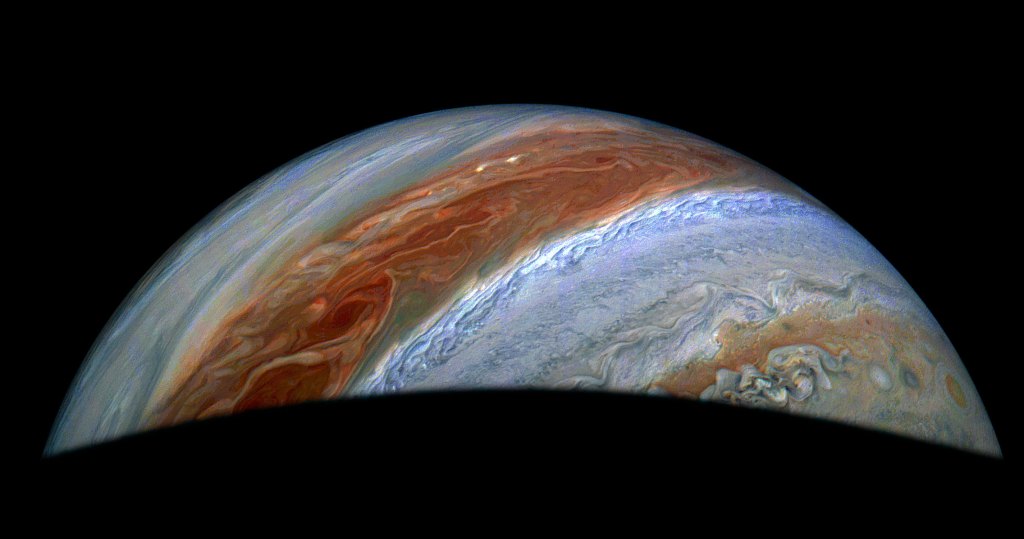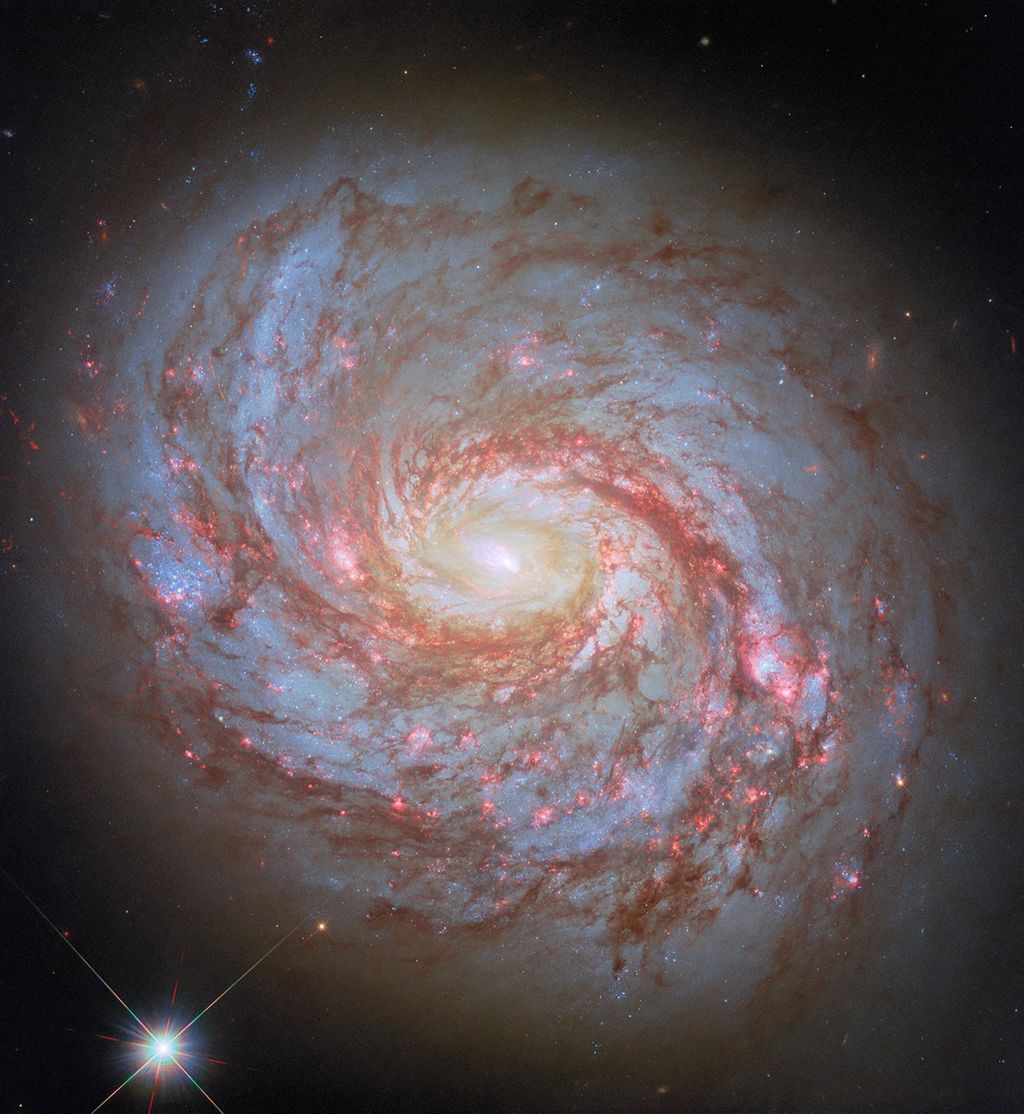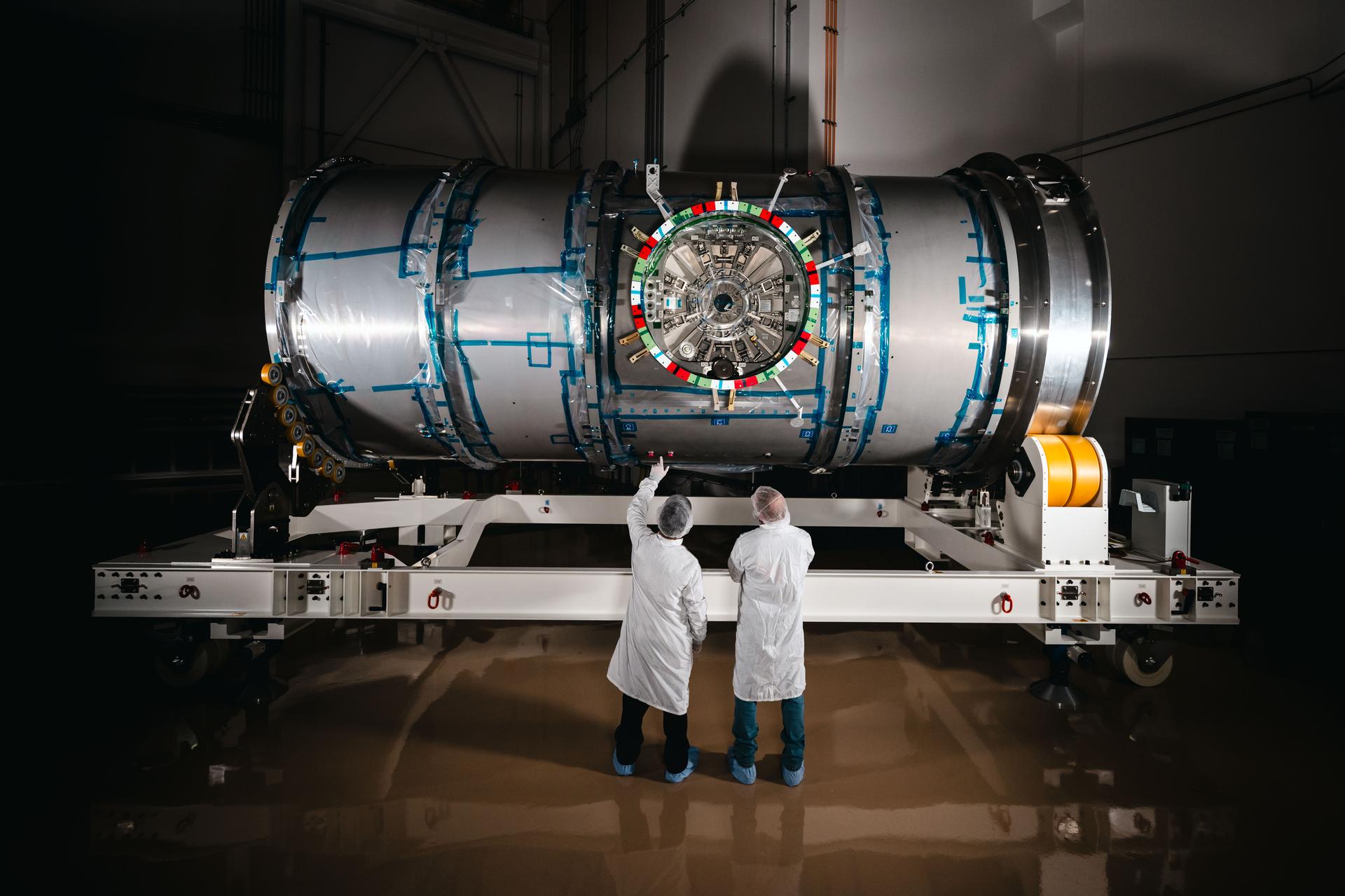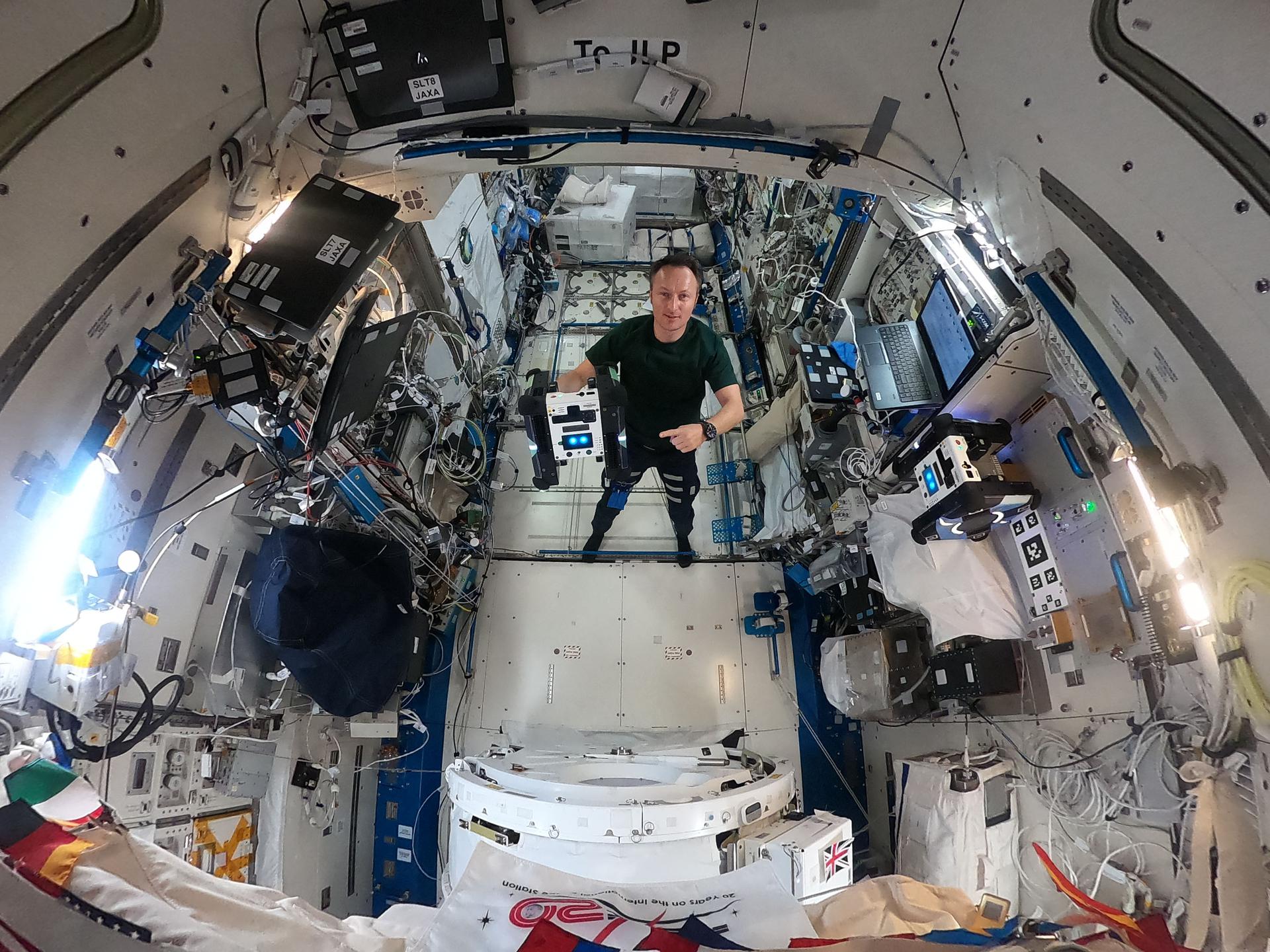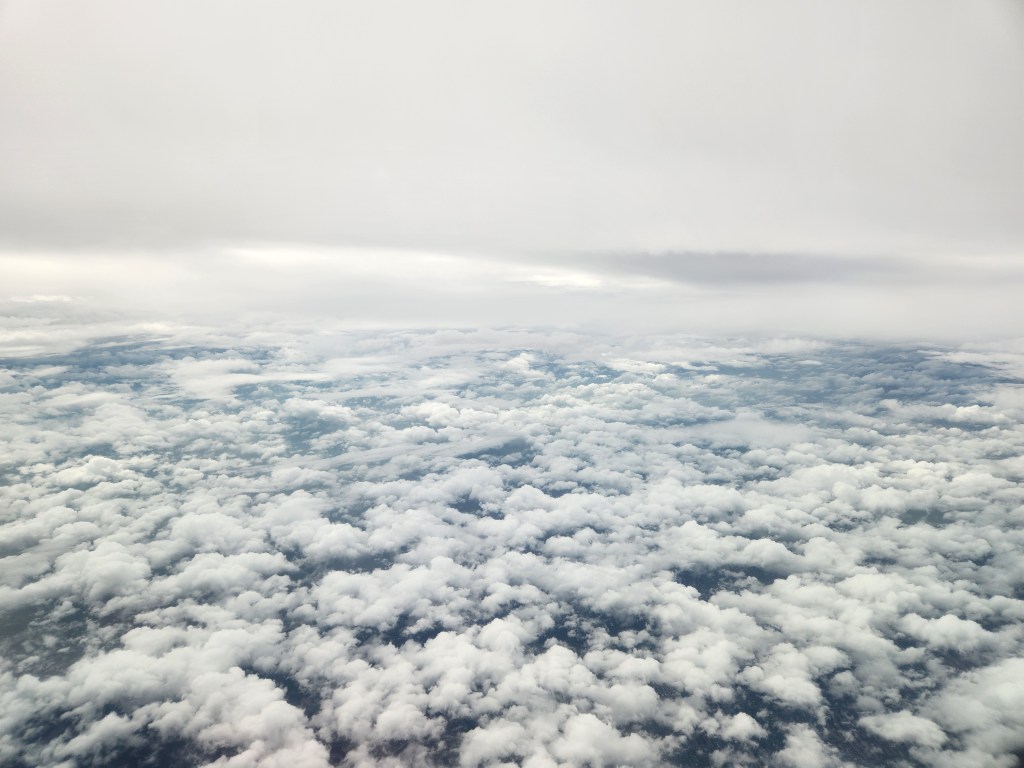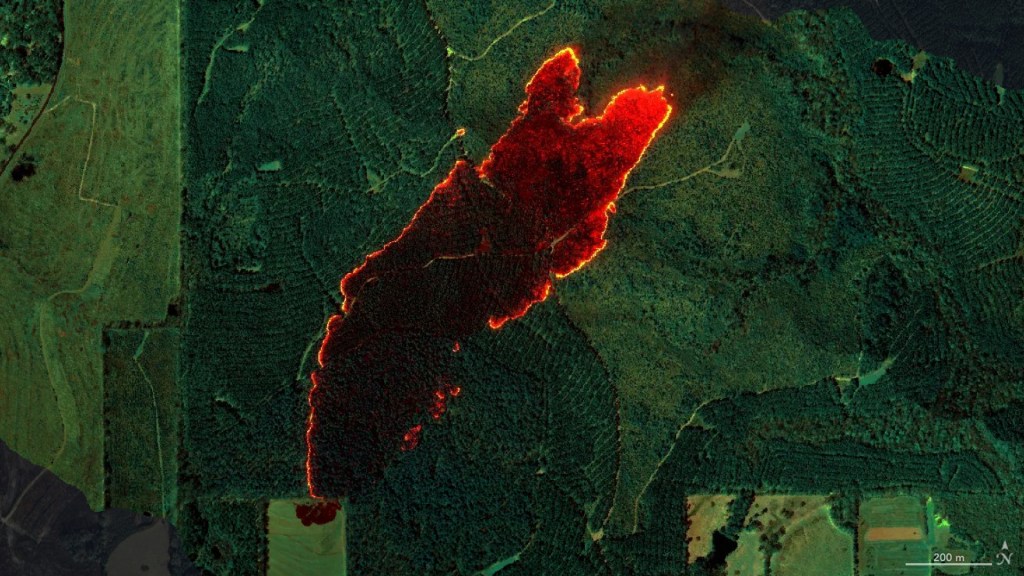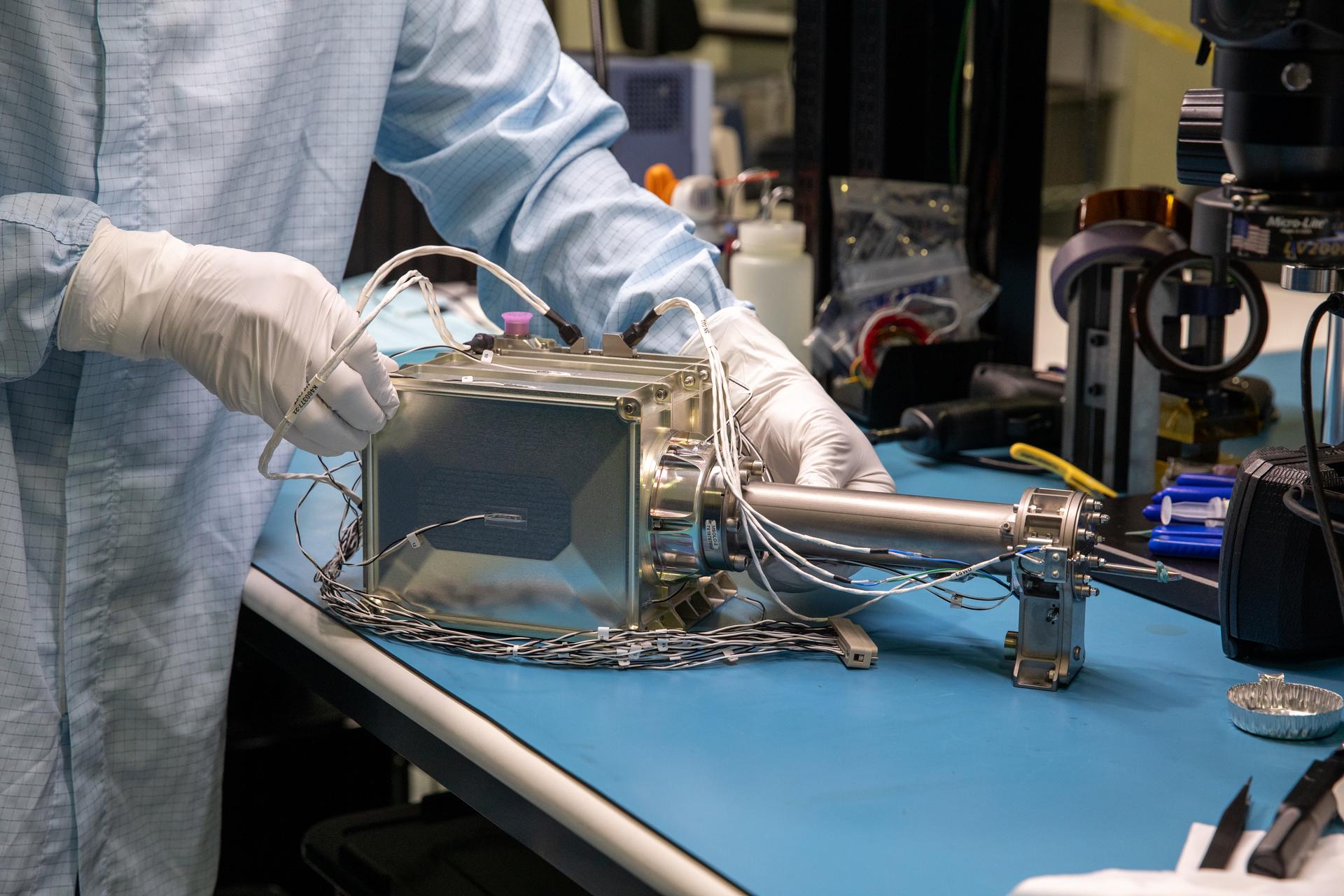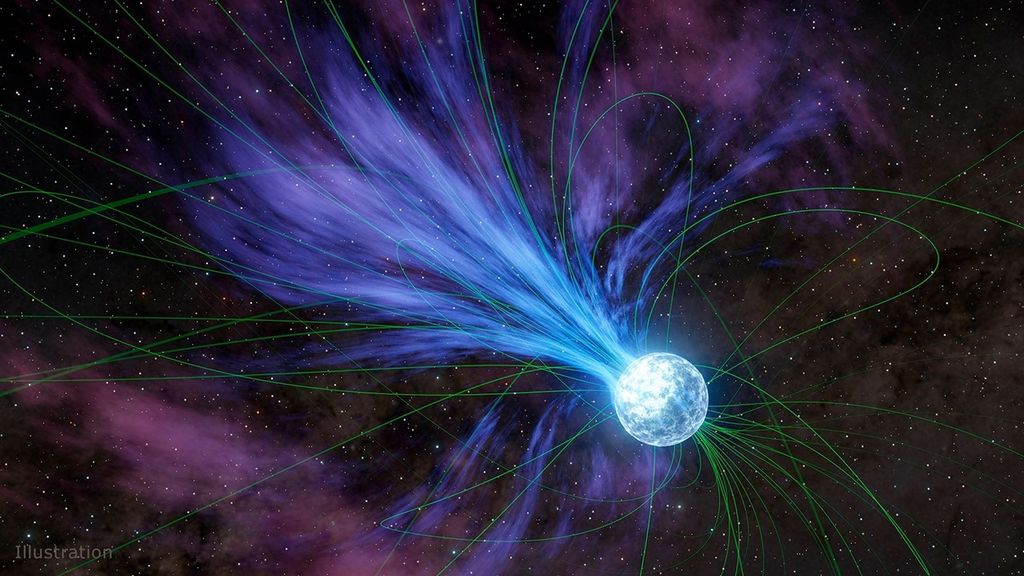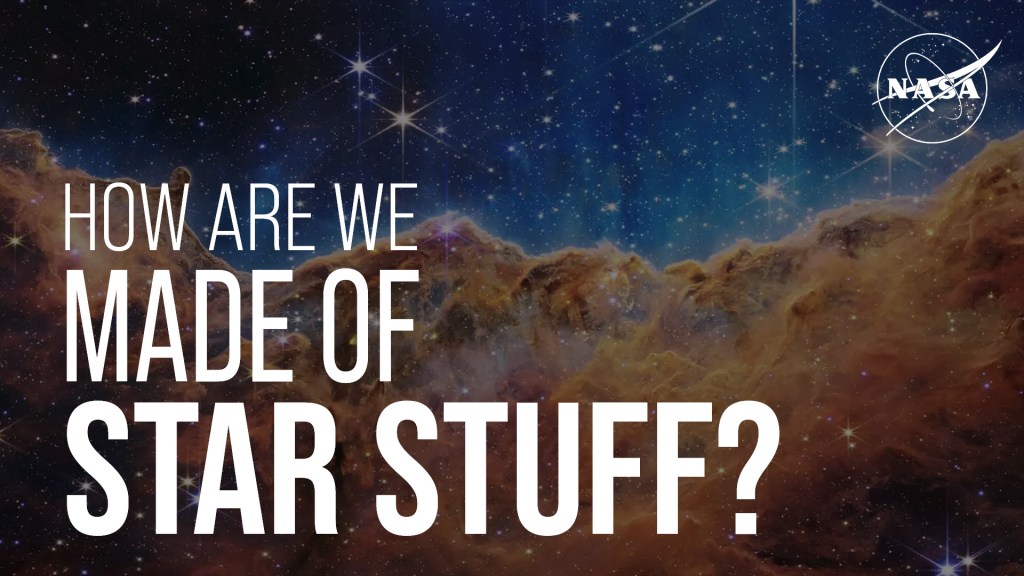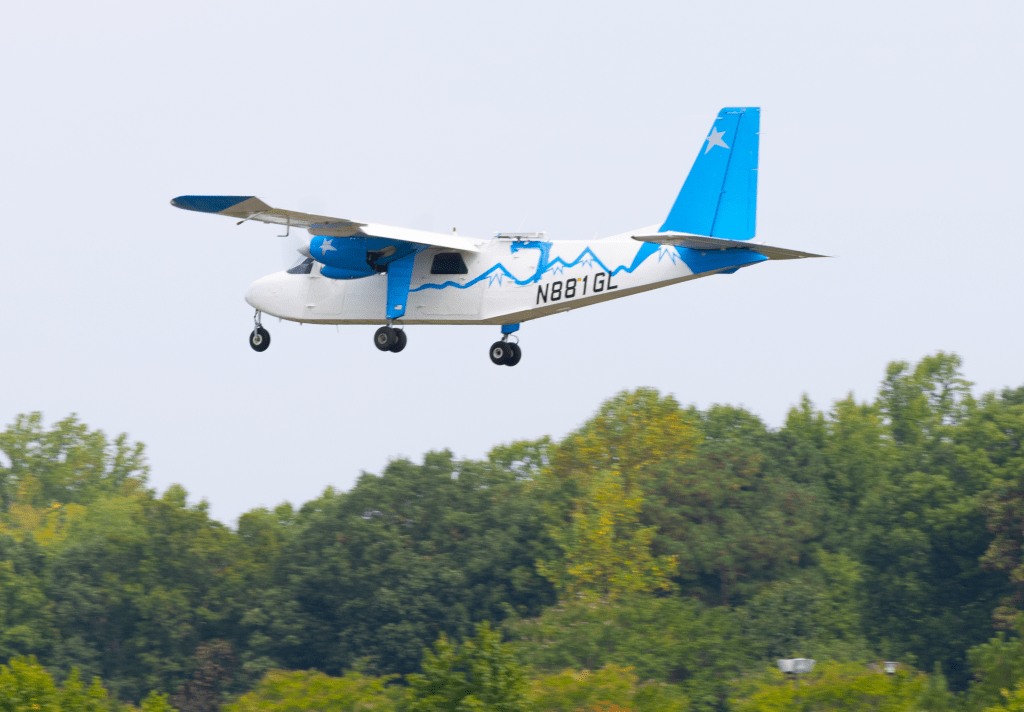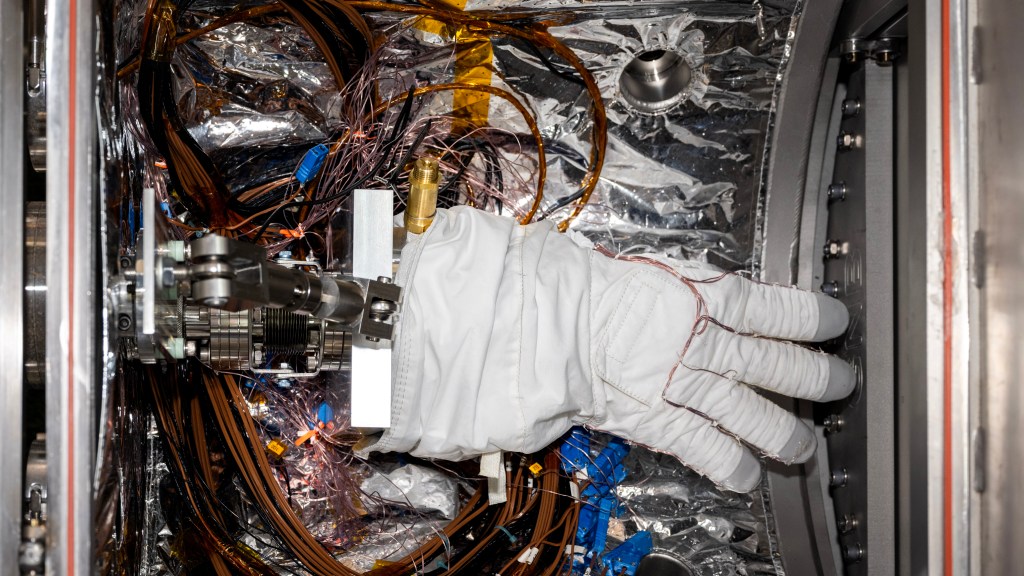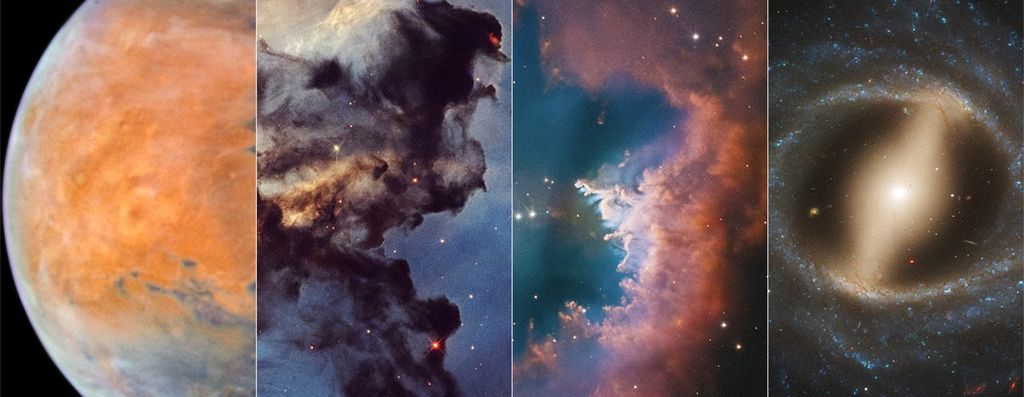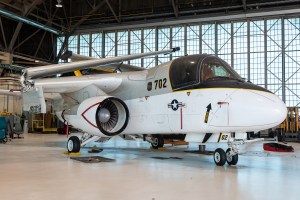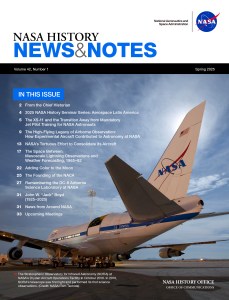On May 24, 1962, astronaut M. Scott Carpenter completed America’s second orbital spaceflight during the Mercury-Atlas 7 mission. Carpenter flew the mission after doctors grounded the prime crew member, astronaut Donald K. “Deke” Slayton, due to a minor heart condition. Naming his spacecraft Aurora 7, Carpenter completed three orbits of the Earth, conducting several experiments including photography of the planet. A problem with the spacecraft’s attitude and the late firing of its retrorockets during the critical reentry burn resulted in Aurora 7 splashing down 250 miles off course. Carpenter waited in his life raft for more than an hour before rescue teams recovered him and flew him safely to the prime recovery ship, the U.S.S. Intrepid aircraft carrier.
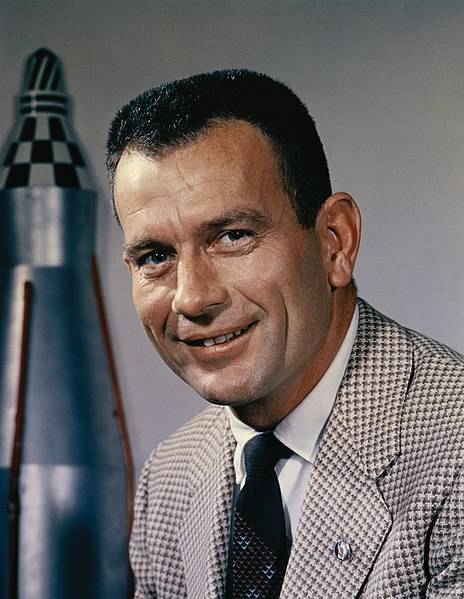
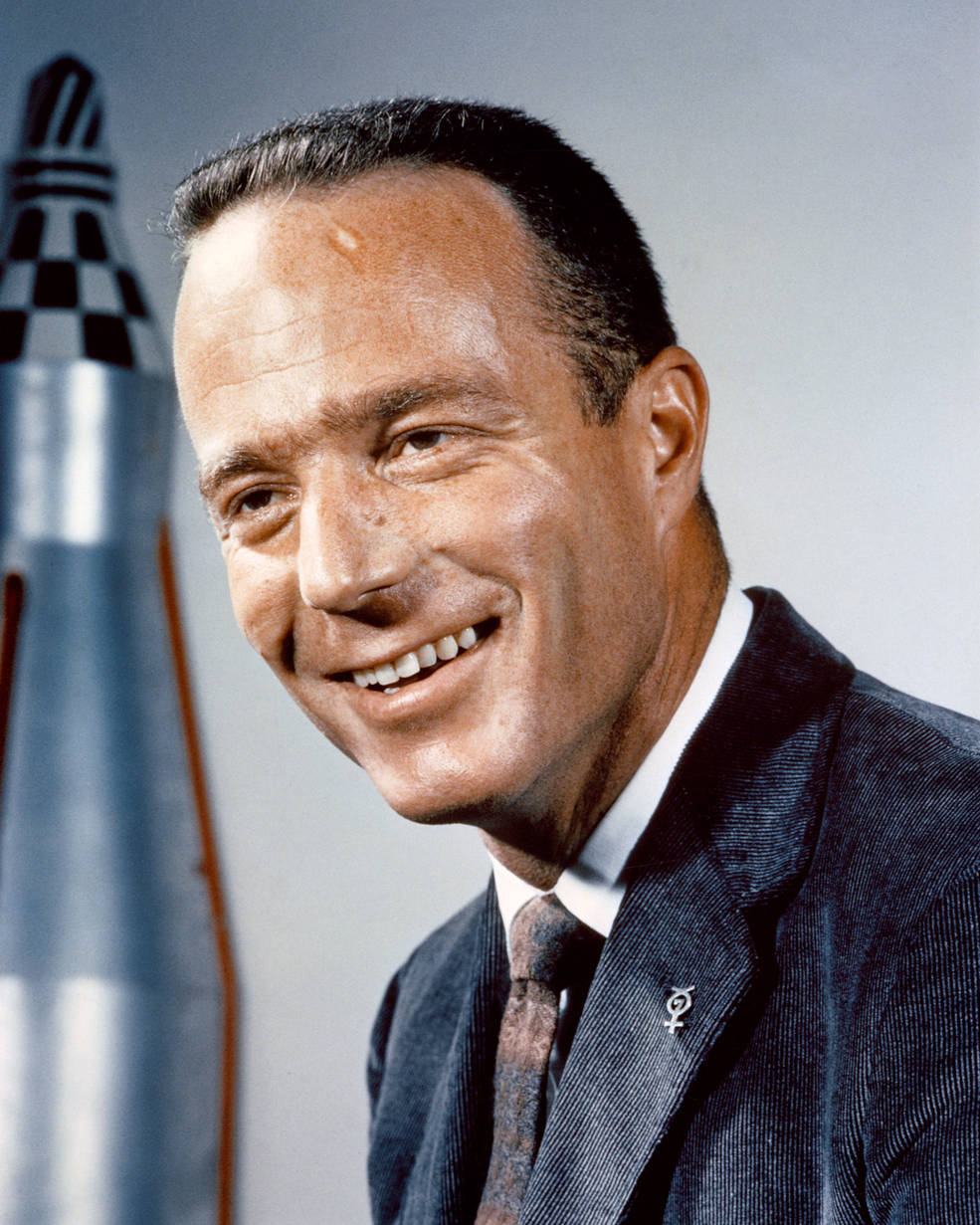
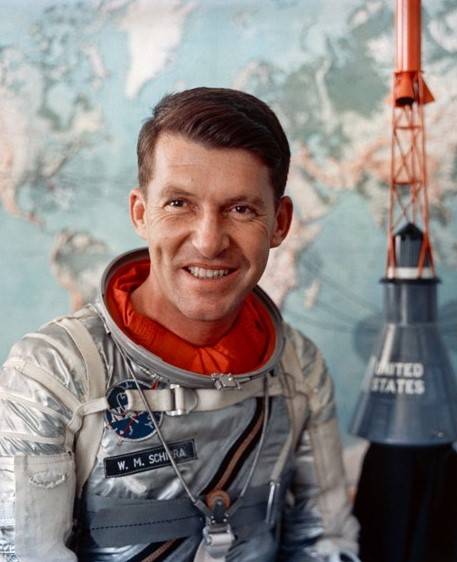
Left: Astronaut Donald K. “Deke” Slayton, originally assigned to the Mercury-Atlas 7 mission. Middle: Astronaut M. Scott Carpenter flew the mission after Slayton’s grounding. Right: Astronaut Walter M. “Wally” Schirra, assigned as Carpenter’s backup.
On March 15, 1962, less than two months before the planned Mercury-Atlas 7 mission, NASA announced the grounding of Slayton after doctors determined that his minor heart irregularity might pose a problem during his flight. Instead of replacing him with his backup, astronaut Walter M. “Wally” Schirra, NASA decided to have Carpenter, who served as backup to John H. Glenn for his historic orbital flight just three weeks earlier, fly the mission, with Schirra serving as his backup. While Slayton had named the Mercury capsule Delta 7, Carpenter instead chose the name Aurora 7. The mission essentially planned to repeat Glenn’s three-orbit flight, with several new experiments added to the flight plan.
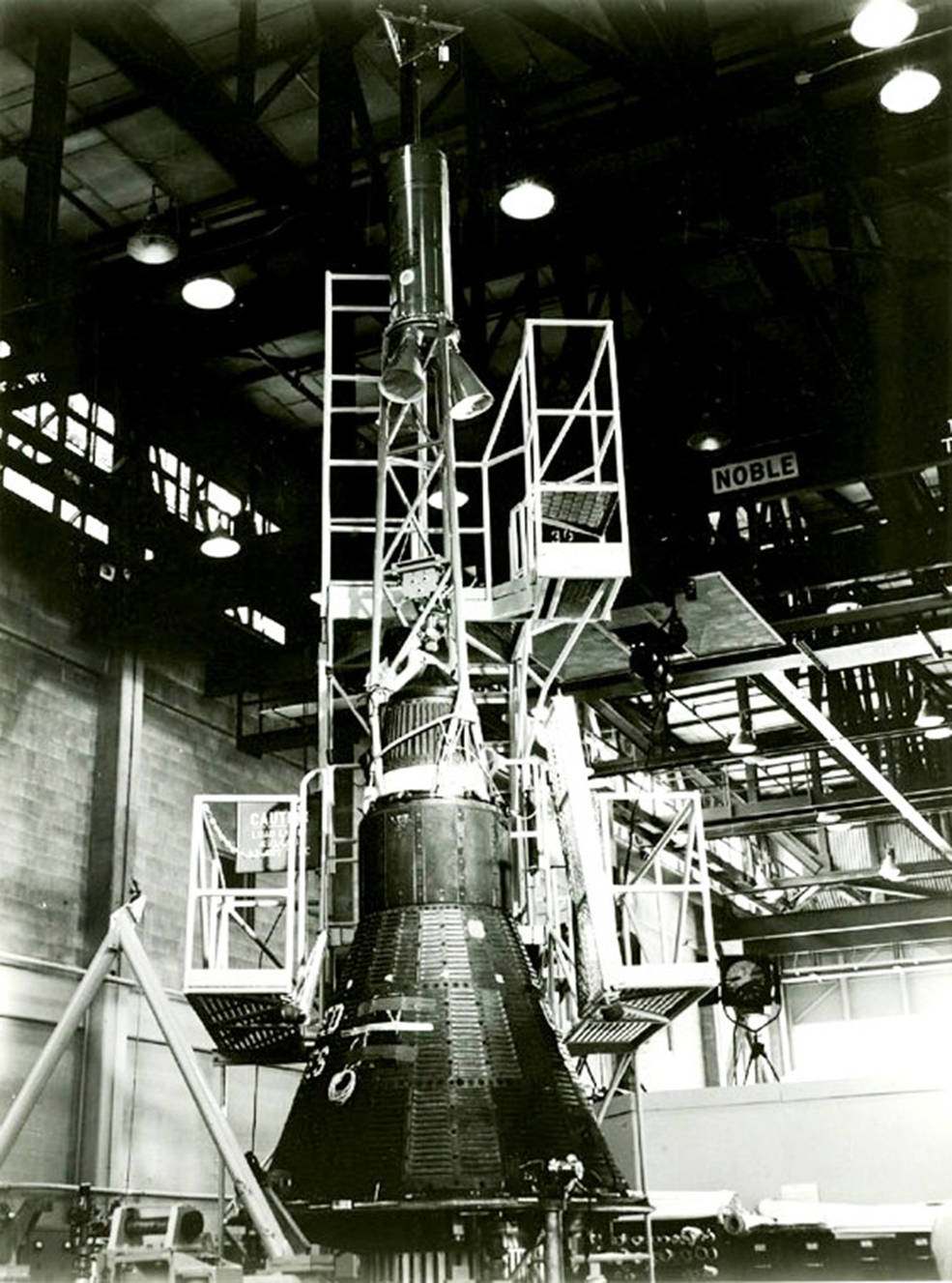
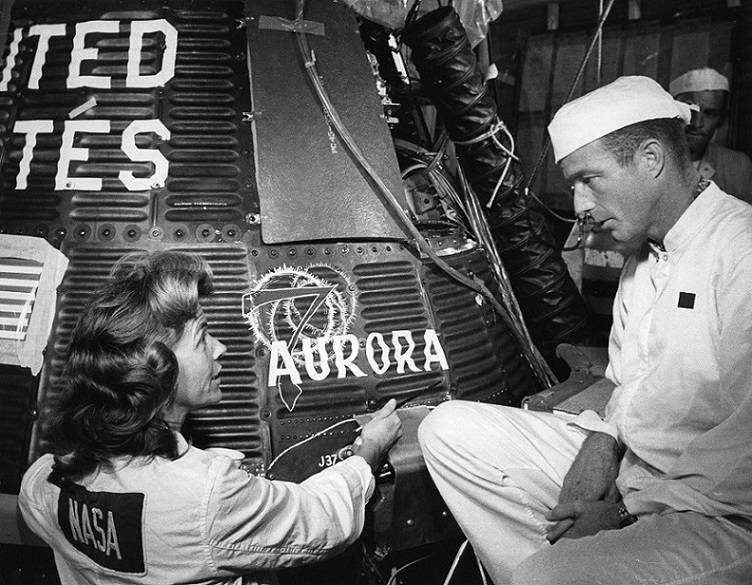
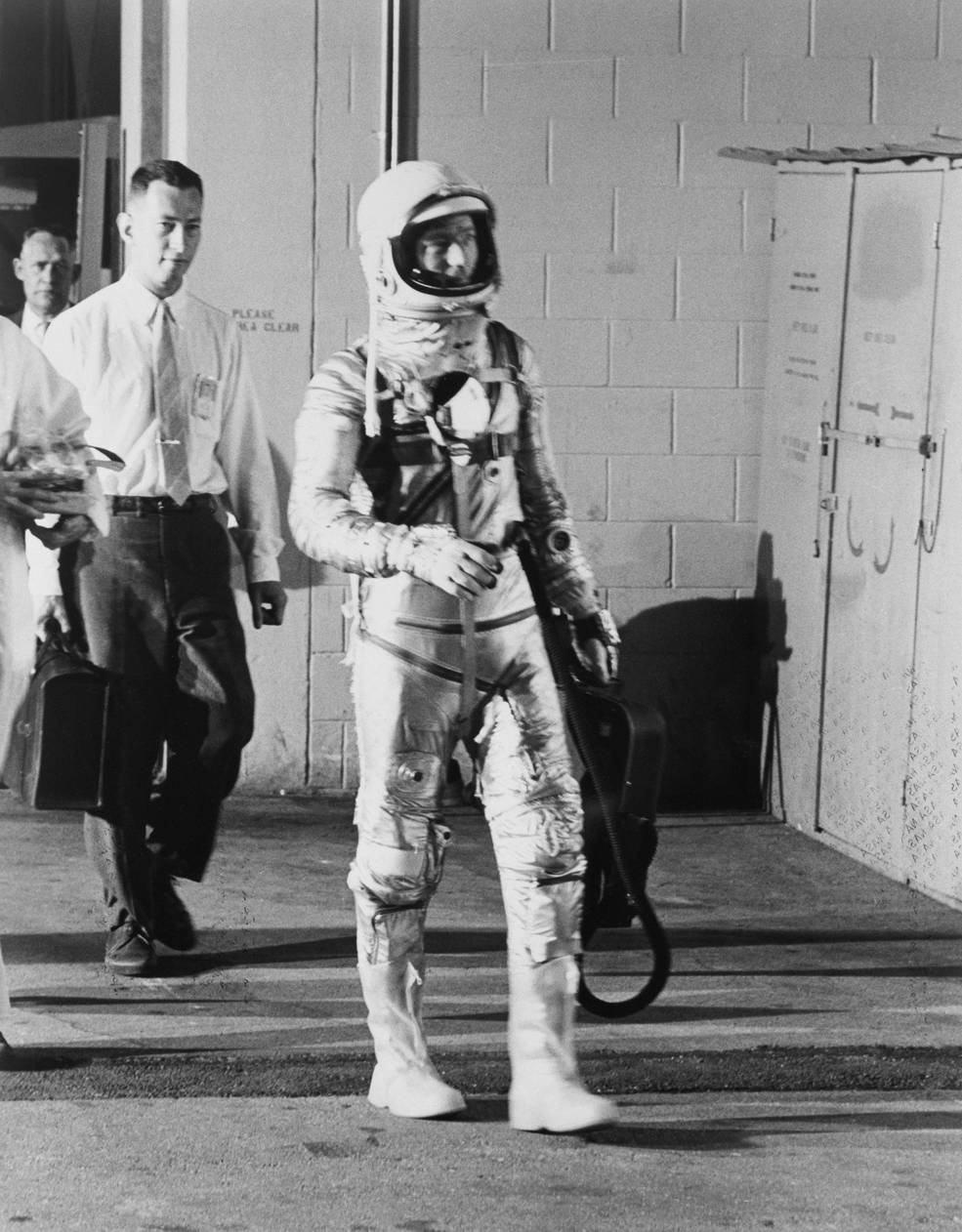
Left: The Mercury-Atlas 7 spacecraft during the preflight weight and balance check in Hangar S at Cape Canaveral Air Force Station, now Cape Canaveral Space Force Station in Florida. Middle: Artist Cecilia “Cece” Bibby, left, paints the Aurora 7 logo ontothe Mercury spacecraft as astronaut M. Scott Carpenter looks on. Right: Carpenter leaves Hangar S to board the transfer van to Launch Pad 14.
At Cape Canaveral Air Force Station, now Cape Canaveral Space Force Station, in Florida, ground crews prepared the Mercury spacecraft and its Atlas booster for flight. The Mercury spacecraft arrived on Nov. 15, 1961, and engineers in Hangar S readied it for its flight. The Atlas booster arrived at the Cape on March 6, 1962, and ground crews lifted it into place at Launch Pad 14. They later installed the Mercury capsule atop the rocket. Following several delays to solve minor issues with the rocket and the spacecraft, managers set May 24 as the launch date.
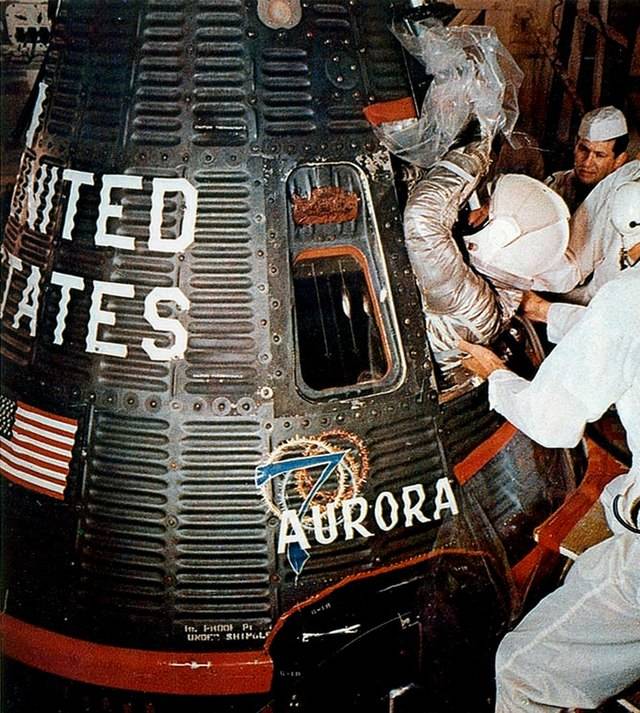
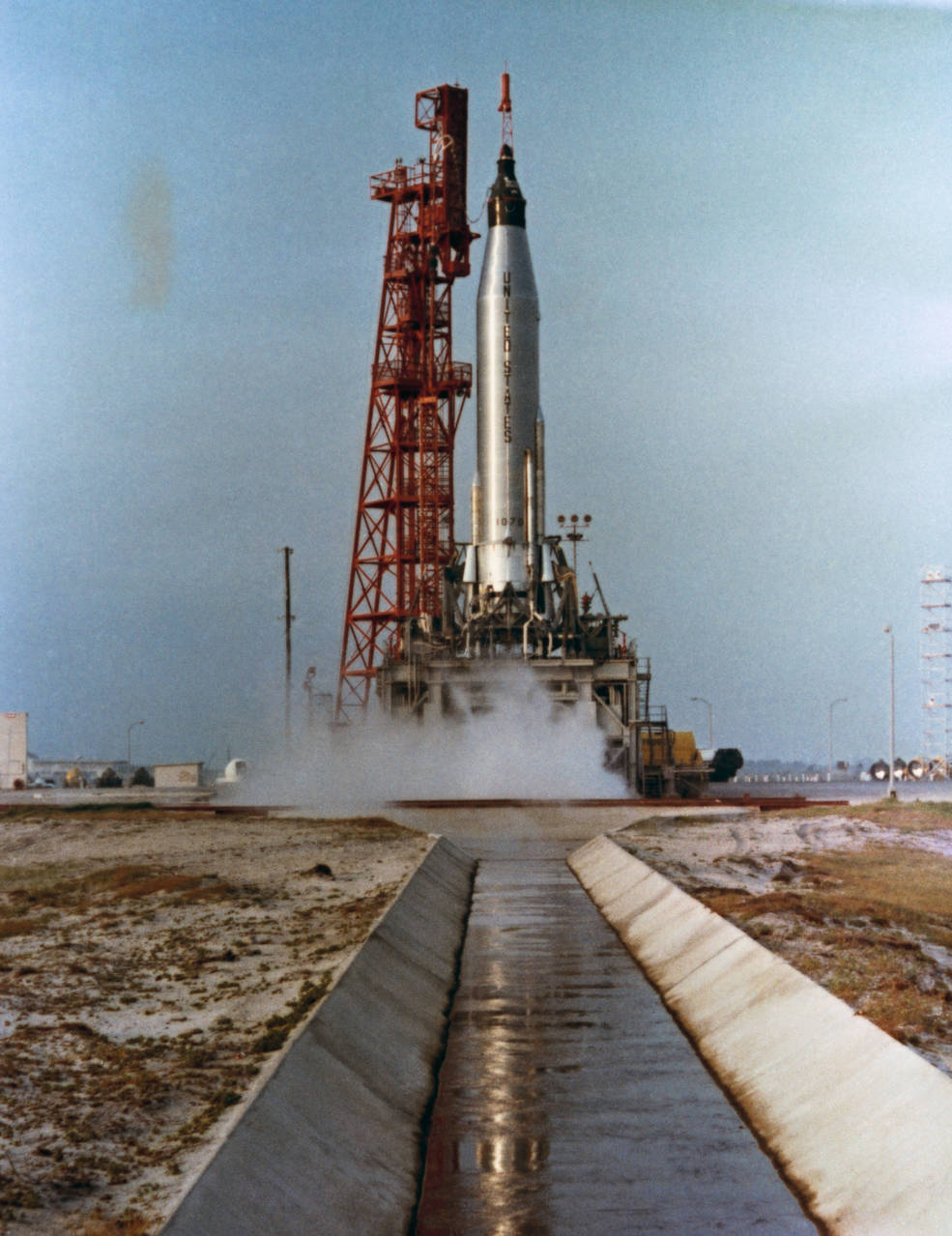
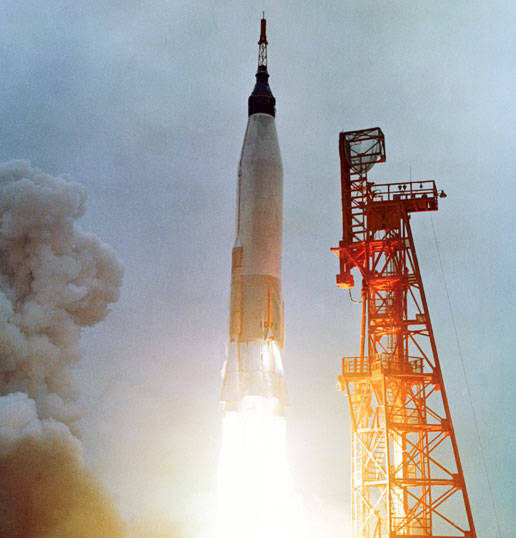
Left: Technicians assist astronaut M. Scott Carpenter in boarding his spacecraft before launch. Middle: The moment of ignition of the Atlas rocket. Right: Liftoff of Mercury-Atlas 7 carrying Carpenter into orbit.
In the pre-dawn darkness of May 24, technicians assisted Carpenter into his spacecraft and sealed the hatch. Following a smooth countdown, flight managers called for a halt at T-minus 11 minutes to allow the Sun to burn off the morning fog. After a 45-minute hold, the countdown resumed and the Atlas rocket carrying Carpenter inside Aurora 7 lifted off into the morning sky, trailing a pillar of flame. “I feel the liftoff,” Carpenter reported to the Mercury Control Center (MCC) at the Cape. “The clock has started.” Astronaut Virgil I. “Gus” Grissom, serving as the capsule communicator, or capcom, gave a terse reply: “Roger.” A team of controllers led by Flight Director Christopher C. Kraft monitored all aspects of the mission from MCC, relying on a global network of communications stations to keep track of the flight’s progress. About two minutes after liftoff, the Atlas rocket’s booster engines cut off and jettisoned, the ascent continuing on the single sustainer engine. Twenty seconds later, the launch escape tower was jettisoned. Five minutes into the flight, the sustainer engine cut off as planned and Aurora 7 separated from the now-empty booster, firing its thrusters to separate from the spent stage. Carpenter was now weightless and in orbit. Carpenter’s first task consisted of turning his spacecraft around, flying blunt end forward. From this position, he could see the Moon and the spent booster slowly tumbling and receding into the distance. He retrieved his camera and began taking photographs of the Earth below him, including his first orbital sunset. In maneuvering his spacecraft, Carpenter used more fuel than expected, an issue that continued throughout his flight. Around this time, his suit’s cooling system malfunctioned, the heat making him uncomfortable. Increasing the water flow in the cooling system temporarily solved the problem. Near the end of his first orbit, Carpenter tested some new food products, consisting of bite-sized portions of compressed food. To help conserve fuel, he placed Aurora 7 into a free-drift mode.
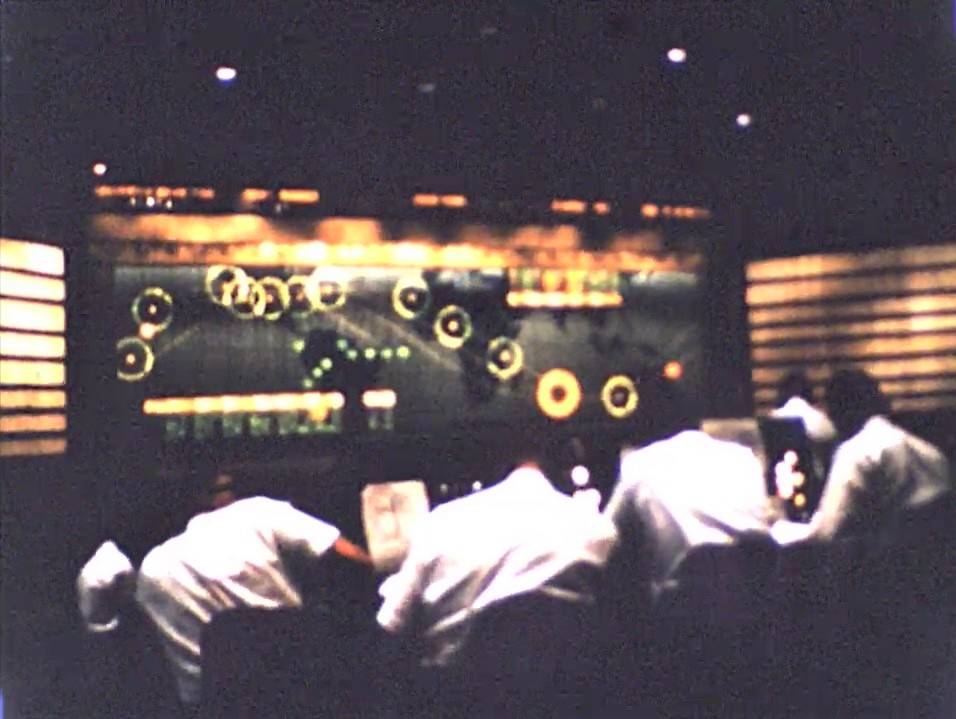
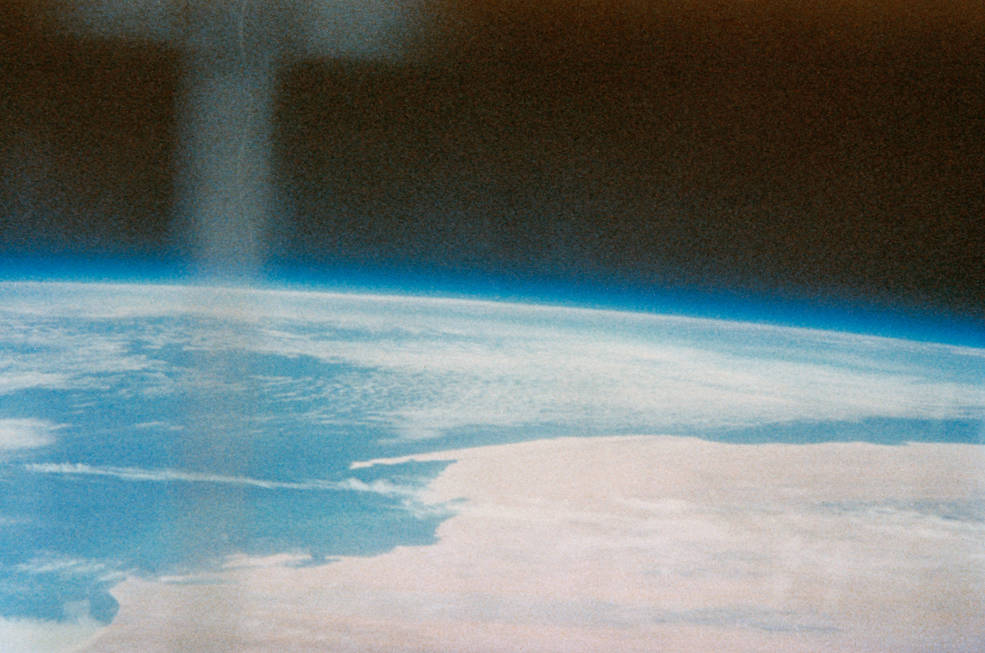
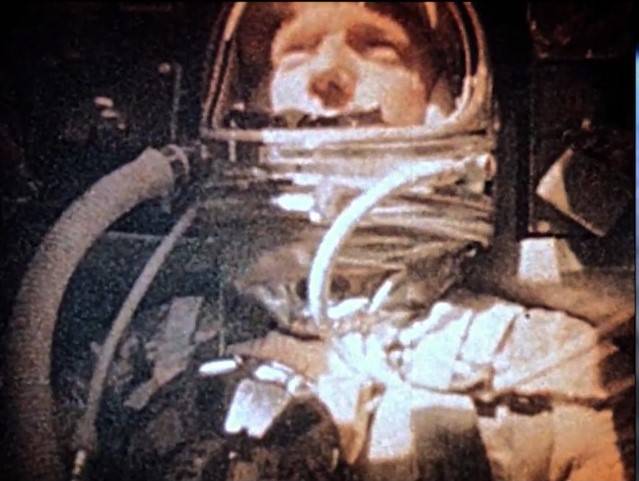
Left: Mercury Control Center at Cape Canaveral Air Force Station, now Cape Canaveral Space Force Station, in Florida during astronaut M. Scott Carpenter’s flight. Middle: View of western Africa and the Atlantic Ocean taken by Carpenter. Right: Still from a film of Carpenter during his three-orbit flight.
By the end of the first orbit, Carpenter had used up nearly half his attitude control fuel, and MCC advised him to conserve enough to assure a full three-orbit mission and a successful retrofire. At the beginning of the second orbit, Carpenter initiated one of the experiments of his mission by deploying a 30-inch balloon tethered to his spacecraft by a 100-foot nylon line. The experimenters painted the balloon in five different colors to determine how colors reflect in space. Another aspect of the experiment involved the dispersion of small discs coated with reflective material. Experimenters also hoped to measure the effect of drag on the balloon as it trailed the spacecraft. Unfortunately, the balloon did not inflate properly due to a tear in a seam, although the discs dispersed as expected but soon disappeared from view. Also, the tether did not remain rigid, causing the balloon to move in random directions. Meanwhile, Carpenter’s suit temperature rose again. Opening his helmet’s visor seemed to help the problem. Although his fuel reserves continued to decrease, MCC gave him a go for his third orbit, but advised him to let the spacecraft drift and to drink as much water as possible to combat any dehydration from his hot suit. As the time approached to align his spacecraft for the retrofire burn, Carpenter fell behind on the timeline, and then the automatic attitude control system provided bad data and he switched to manual control. When the retrorockets didn’t fire automatically as expected, Carpenter fired them manually, delaying the start of ignition by three seconds. At his spacecraft’s velocity, the delay pushed his splashdown point 15 miles beyond the planned target. Engineers later discovered that the retrorockets underperformed, adding another 60 miles to the overshoot, and the capsule’s orientation during the retrofire had been off by 25 degrees, resulting in the overall 250-mile overshoot. To make problems worse, Carpenter fuel supplies approached zero as he tried to reorient the spacecraft for reentry. As the capsule entered the atmosphere, the plasma cloud formed around it prevented communications with the ground for nine minutes. As he descended deeper into the atmosphere, the spacecraft began to oscillate, but Carpenter had no fuel left to orient it. To help stabilize the capsule, he deployed the drogue parachute early at 25,000 feet and the main parachute at 9,500 feet. Because of the landing overshoot, communications with MCC proved impossible, although Grissom, transmitting in the blind, informed Carpenter that it might take recovery forces an hour to reach him after splashdown.
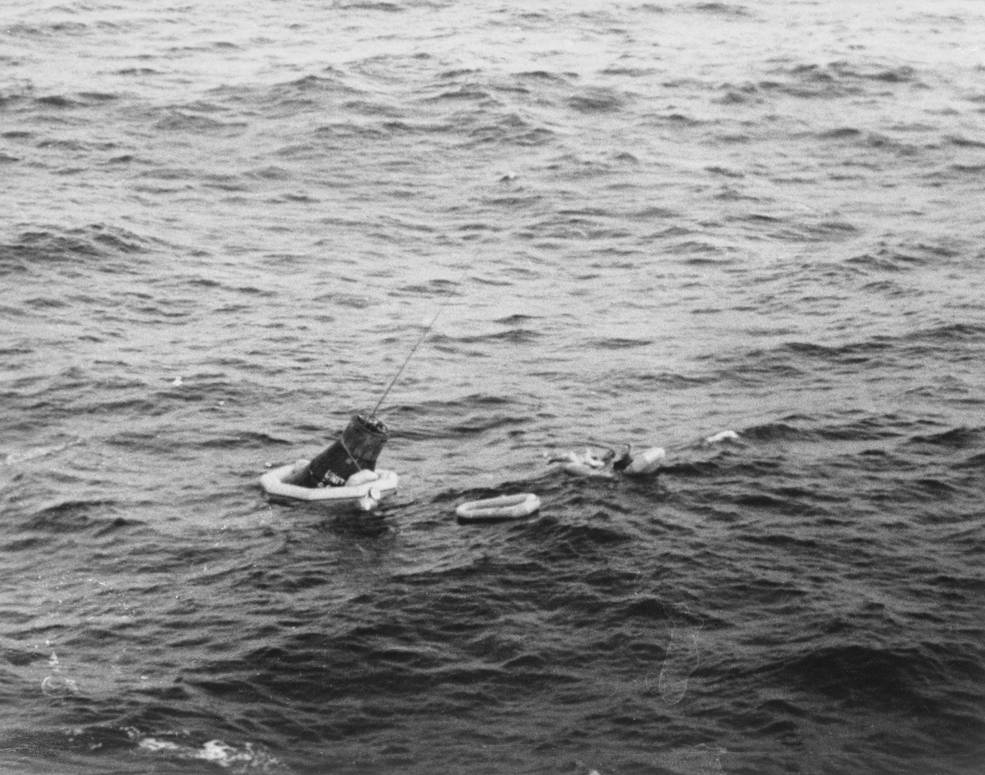
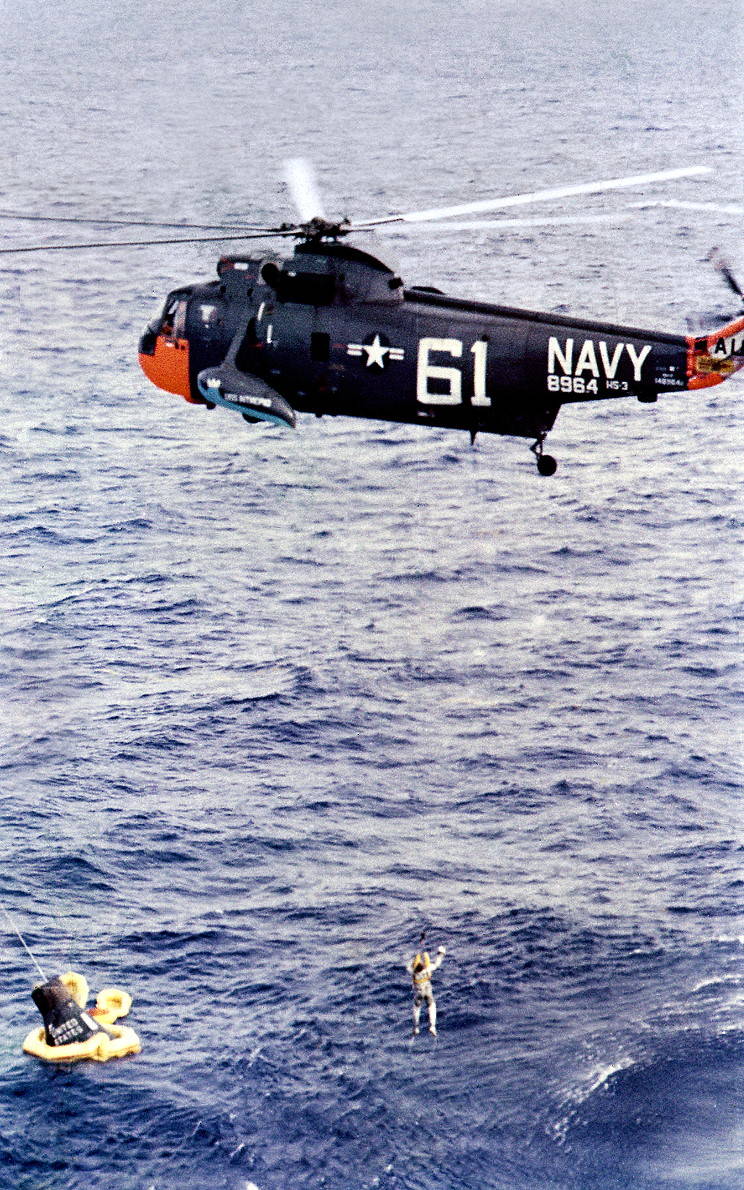
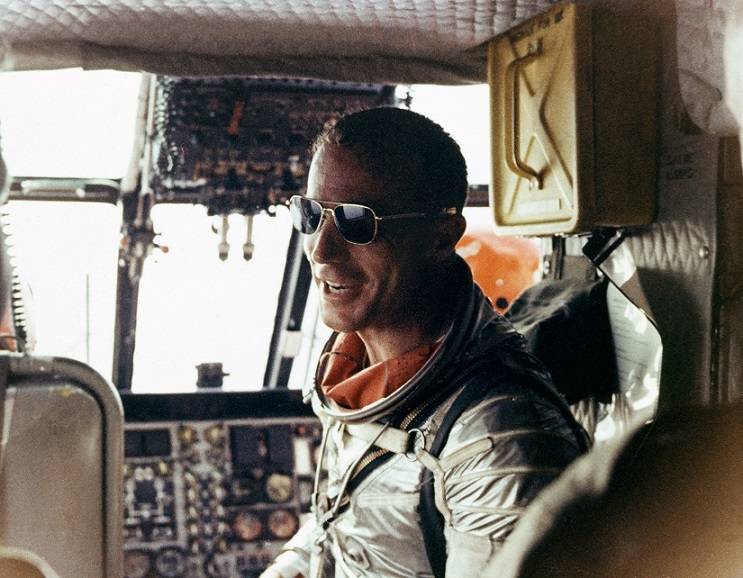
Left: Astronaut M. Scott Carpenter and a rescue frogman on their life rafts near the Aurora 7 capsule one hour following splashdown. Middle: Carpenter being hoisted to the recovery helicopter nearly three hours after splashdown. Right: Carpenter aboard the recovery helicopter during the flight back to the prime recovery ship U.S.S. Intrepid.
Aurora 7 splashed down in the Atlantic Ocean near Anegada Island in the U.S. Virgin Islands, completing a flight of 4 hours, 53 minutes, and 47 seconds. The landing occurred several hundred miles from the prime recovery ship the aircraft carrier U.S.S. Intrepid (CVS-11), and in fact none of the recovery ships had deployed this far downrange. Knowing recovery forces would take at least an hour to reach him, Carpenter decided to exit his spacecraft, which had taken on some water and listed by about 45 degrees. He elected to squeeze through the small hatch at the top of the spacecraft, and lowered himself into the water, pulling his life raft after him. After getting into the life raft, he tied it to the spacecraft and awaited the recovery teams. A reconnaissance aircraft deployed from Naval Air Station (NAS) Roosevelt Roads, Puerto Rico, spotted Carpenter in his raft 40 minutes after splashdown. Nineteen minutes later, two Air Force pararescue frogmen parachuted into the water and swam to Carpenter. Another aircraft dropped a large life raft and an inflatable collar that the frogmen attached around the capsule. Carpenter offered the frogmen some of his rations, but they declined. Soon after rescuers had located Aurora 7 and established Carpenter’s good condition, two helicopters launched from Intrepid to execute the recovery. Three hours after splashdown, rescuers hoisted Carpenter aboard one of the helicopters and began the flight back to Intrepid.

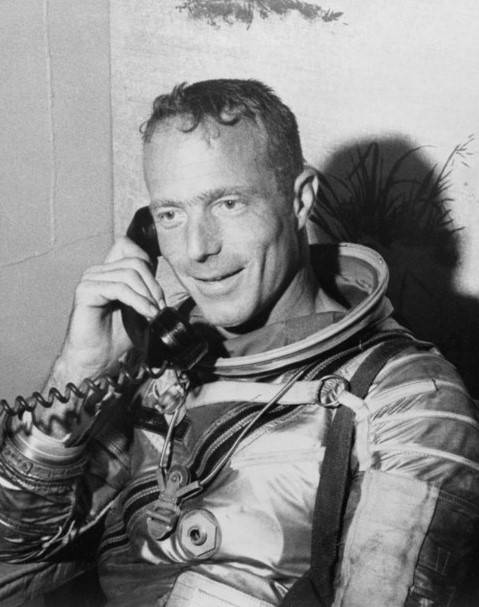
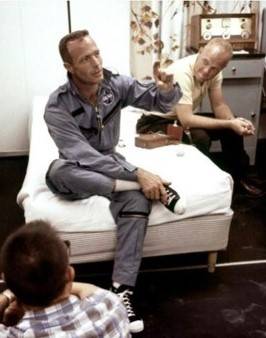
Left: Astronaut M. Scott Carpenter steps aboard the prime recovery ship U.S.S. Intrepid after recovery from his orbital mission. Middle: Aboard Intrepid, Carpenter receives a congratulatory phone call from President John F. Kennedy. Right: Carpenter, left, talks about his mission on Grand Turk Island as astronaut John H. Glenn listens.
One hour later, the helicopter landed on the deck of Intrepid and Carpenter stepped off, greeted by the ship’s crew and cheering sailors. For the next two hours, doctors examined Carpenter and declared him to be in excellent health. President John F. Kennedy telephoned to congratulate him on his mission. Carpenter changed out of his spacesuit and into blue overalls and departed the carrier six and a half hours after splashdown aboard an aircraft that took him to Grand Turk Island in the Turks and Caicos Islands for two days of technical debriefings. Glenn and Schirra met Carpenter as he landed on Grand Turk, while fellow astronauts Grissom and L. Gordon Cooper joined them later. Carpenter received a thorough medical examination by the same team of physicians who examined him before the flight.
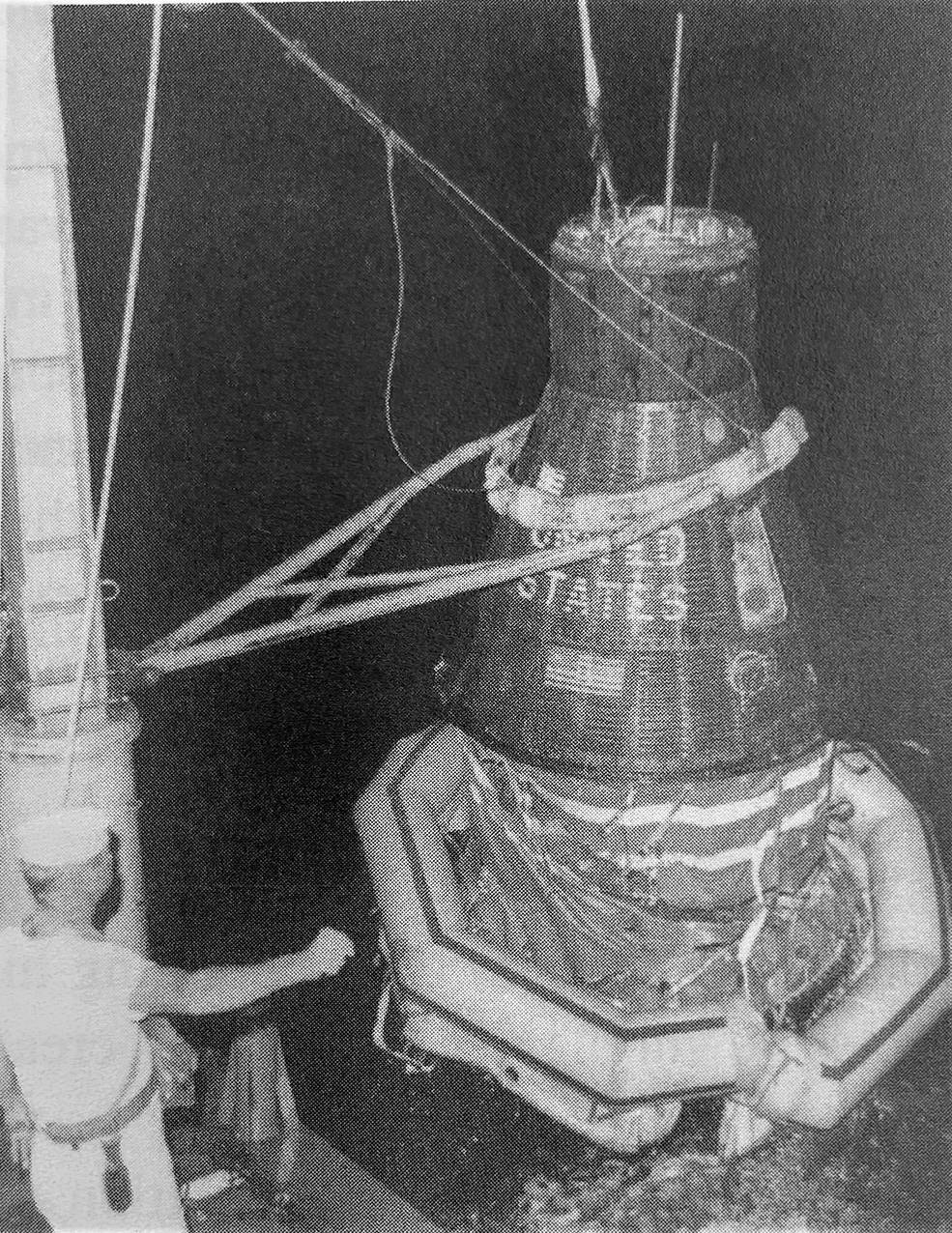
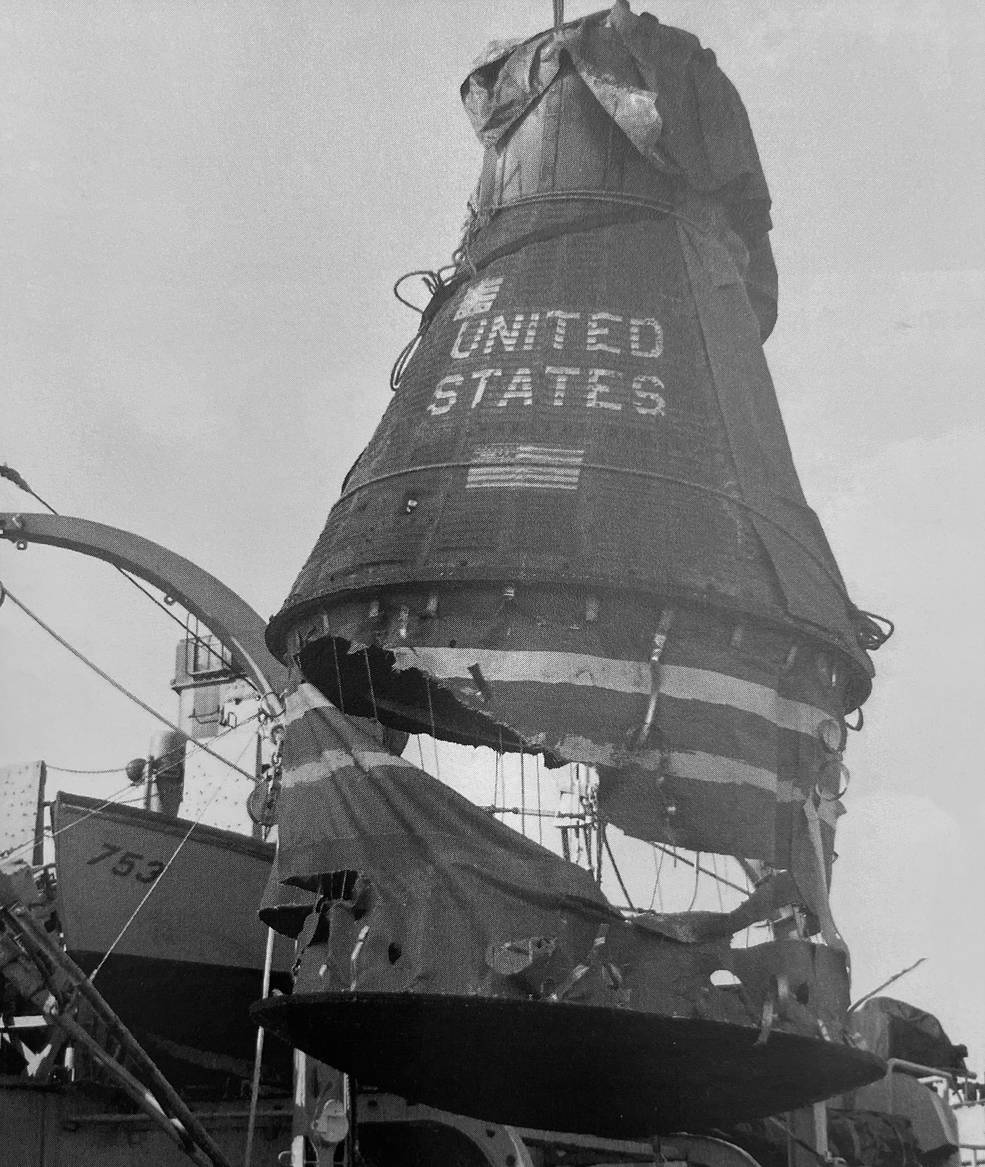
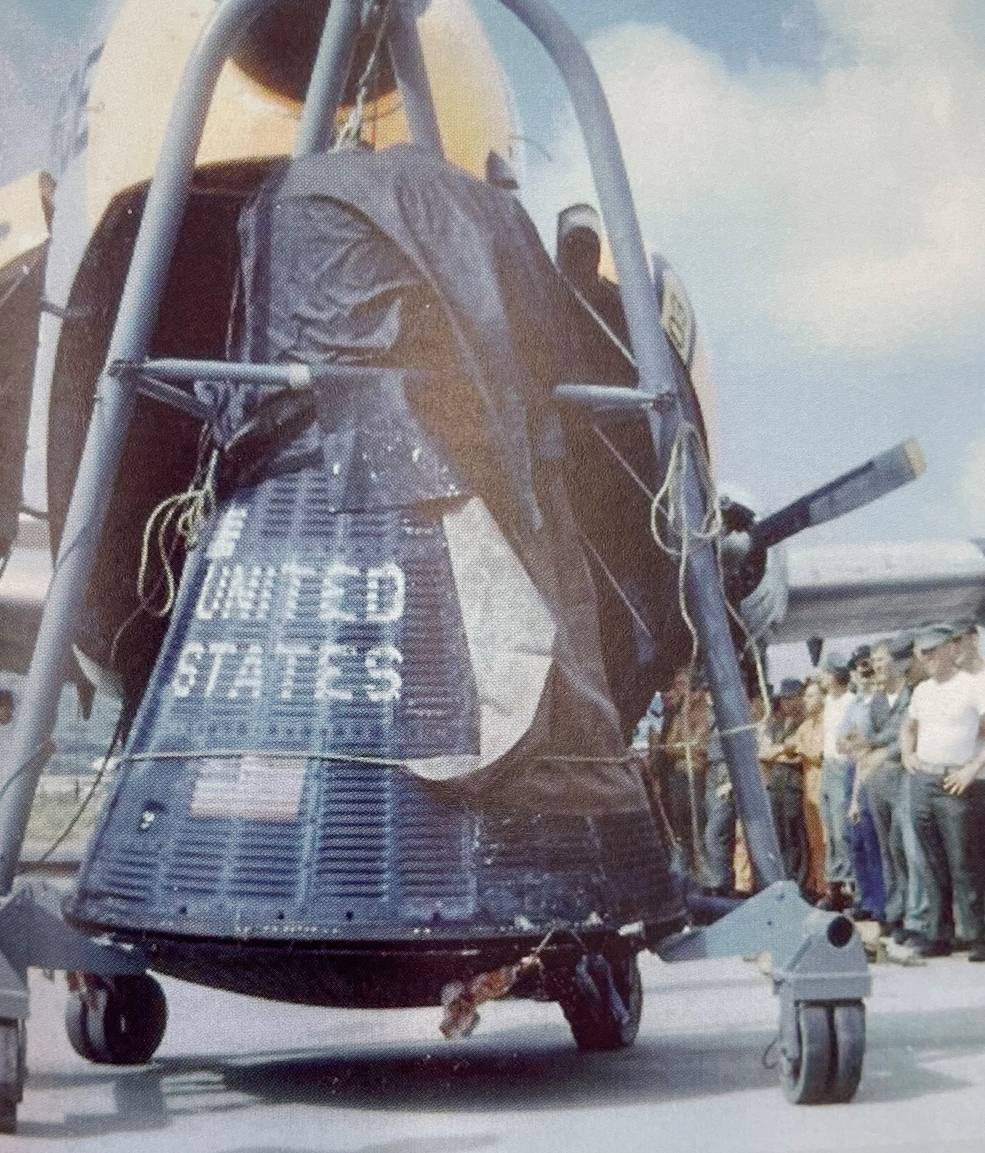
Left: Sailors aboard the U.S.S. John R. Pierce retrieve Aurora 7 from the Atlantic Ocean.
Middle: Sailors from the U.S.S. John R. Pierce offload Aurora 7 at Roosevelt Roads,
Puerto Rico. Right: Ground crews at Roosevelt Roads load Aurora 7 onto a cargo
plane bound for Cape Canaveral, Florida.
Meanwhile, following the off-target splashdown, the destroyer U.S.S. Farragut (DLG-6), located about 100 miles away, reached the spacecraft about four hours after landing. Because the Farragut did not carry equipment to recover the capsule, she kept watch over it until the destroyer U.S.S. John R. Pierce (DD-753) arrived on scene. In a nighttime operation, sailors from that ship retrieved Aurora 7 from the water and had it on the deck six hours and 11 minutes after splashdown. The capsule contained about 60 gallons of sea water, but the collar the frogmen had attached to it kept Aurora 7 from sinking. The John R. Pierce delivered the spacecraft to NAS Roosevelt Roads, from where an Air Force cargo plane delivered it to Cape Canaveral, arriving there on May 25.
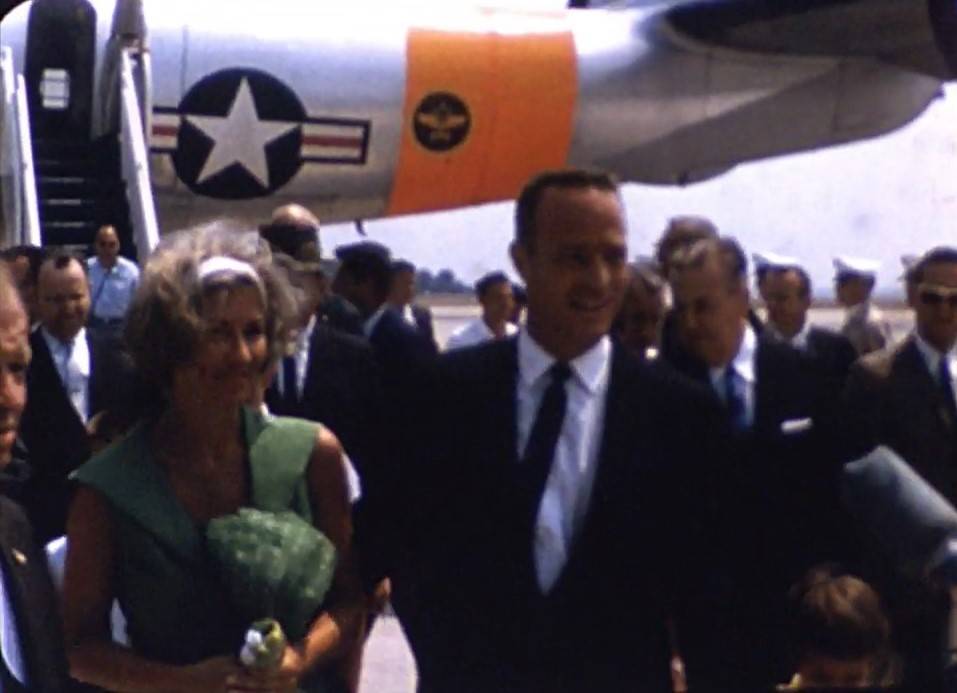
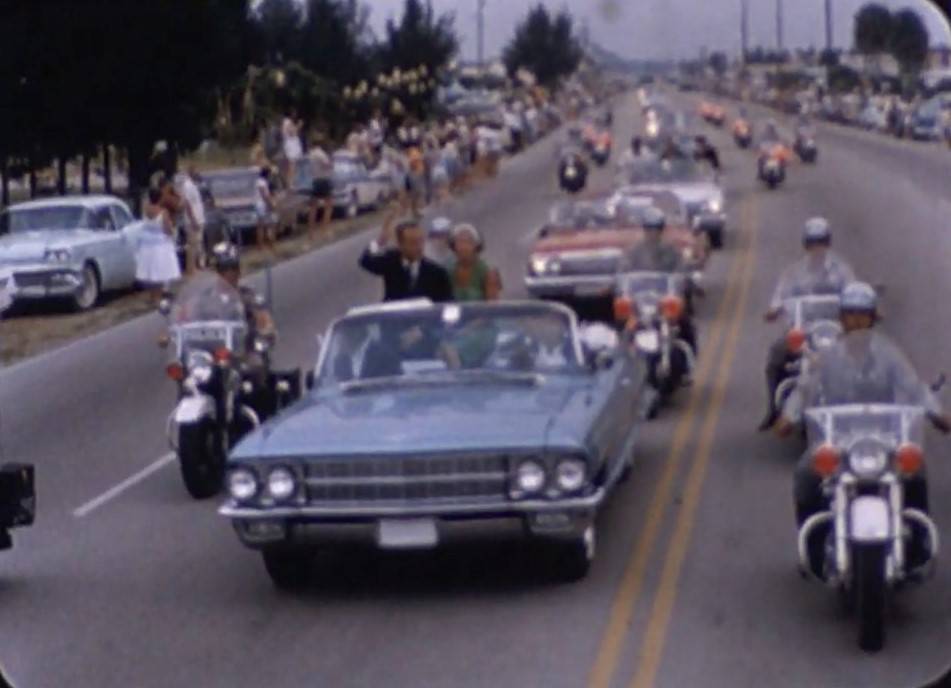
Left: Astronaut M. Scott Carpenter, right, greets his wife Rene after landing at Patrick Air Force Base. Right: The Carpenters ride in a motorcade through Cocoa Beach, Florida, on their way to Cape Canaveral Air Force Base, now Cape Canaveral Space Force Base.
On May 28, an Air Force plane carried Carpenter from Grand Turk to Patrick Air Force Base in Florida, where his wife Rene and four children greeted him. They took part in a motorcade north along Highway A1A in Cocoa Beach, where thousands of well-wishers greeted them on their way to a celebration outside Hangar S at Cape Canaveral.
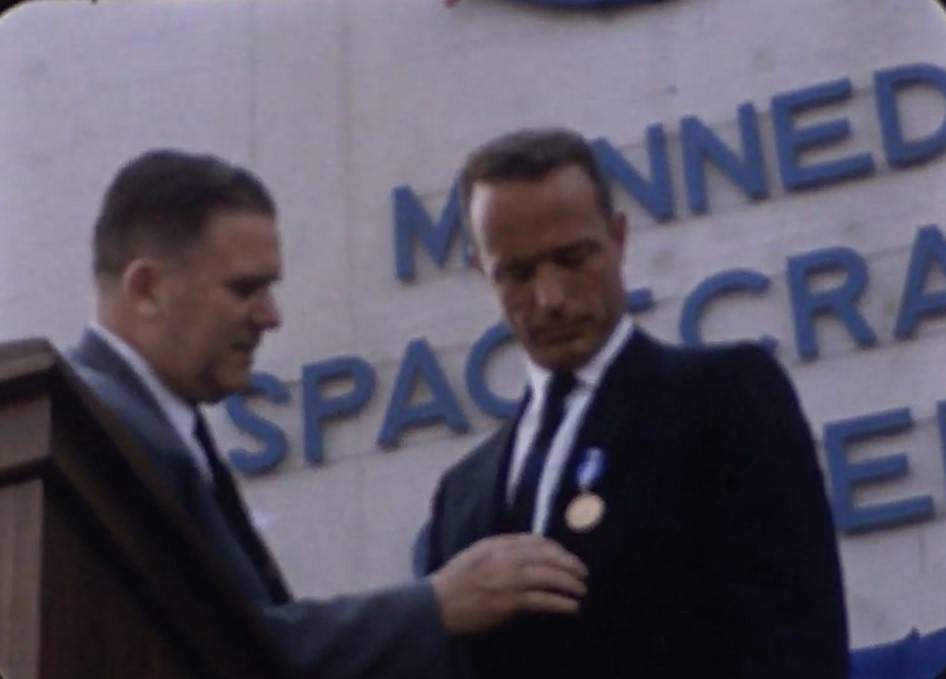
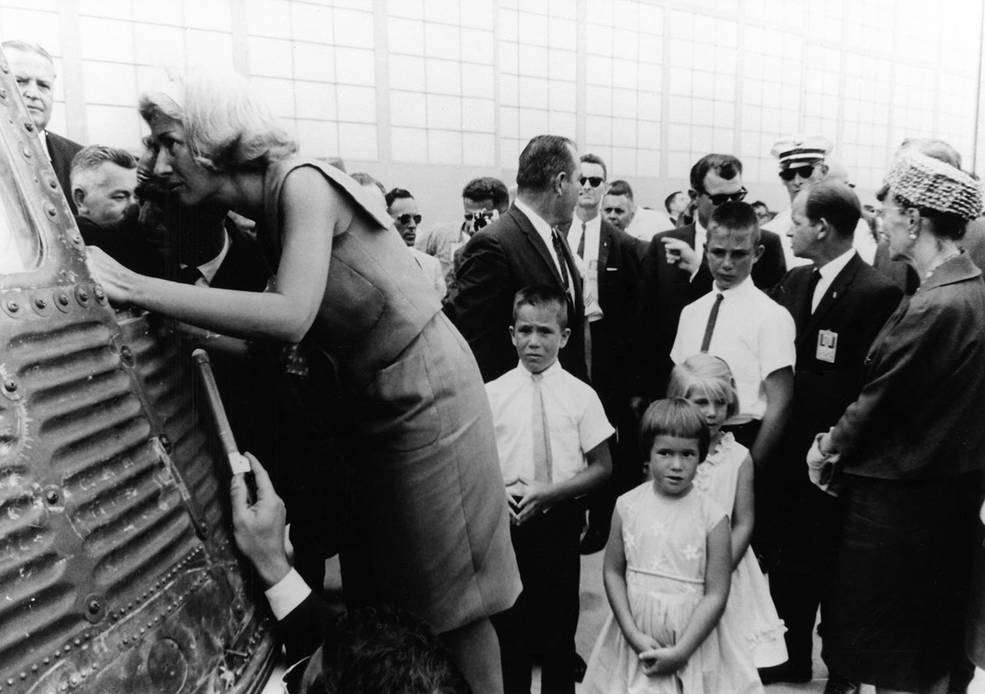
Left: NASA Administrator James E. Webb pins the NASA Distinguished Service Medal on astronaut M. Scott Carpenter in honor of his Mercury-Atlas 7 mission. Right: Carpenter, left, shows his wife Rene the inside of his Aurora 7 spacecraft as their four children look on.
In a brief ceremony outside Hangar S, NASA Administrator James E. Webb presented Carpenter with the NASA Distinguished Service Medal for his Mercury-Atlas 7 mission. In accepting the award, he said, “I humbly accept this on behalf of all the many people on whom these flights depend.” The astronaut reunited with Aurora 7 and showed the inside of the capsule to his wife and children. Carpenter then participated in a press conference, answering reporters’ questions about his mission.
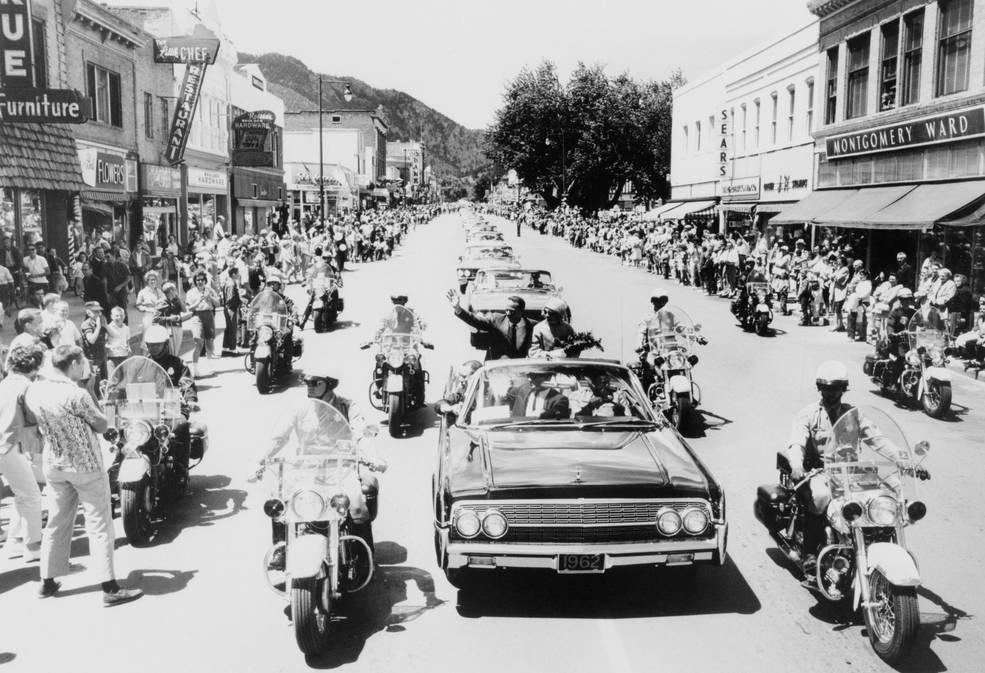
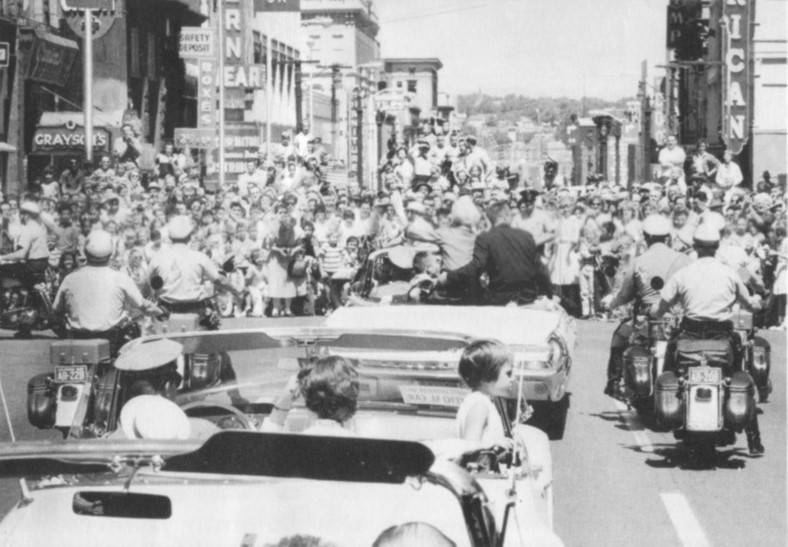
Left: The Carpenters in the motorcade down the streets of Boulder, Colorado. Right: The Carpenters in the Memorial Day parade in Denver.
Following the festivities at Cape Canaveral, the Carpenters boarded a jet at Patrick Air Force Base for a flight to Carpenter’s home state of Colorado. Governor Stephen L. McNichols and Mayor Richard Y. Batterton greeted them at Denver’s Stapleton Field, from where they took a motorcade to Carpenter’s hometown of Boulder. The next morning, in a ceremony at the University of Colorado’s Folsom Stadium, an estimated 17,000 people gathered to honor Carpenter, who received a Bachelor of Science degree in aeronautical engineering that he never finished in 1949 when he joined the U.S. Navy. A motorcade through the streets of Boulder followed the ceremony. On to Denver, the Carpenters participated in that city’s Memorial Day parade, attended by a then-record crowd estimated at more than 250,000 people.
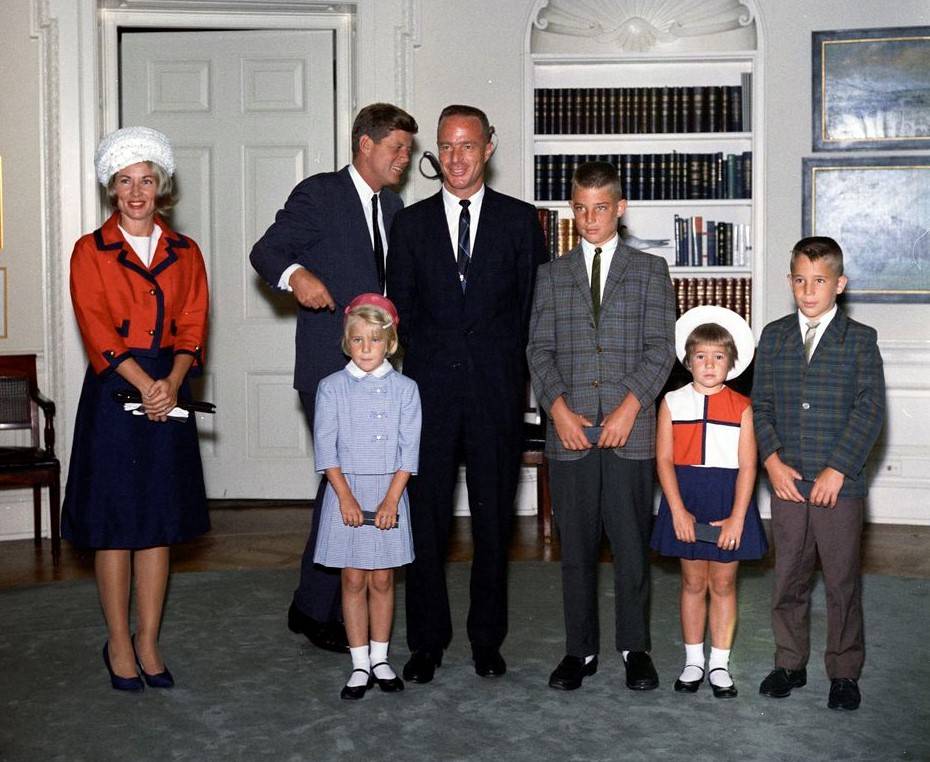
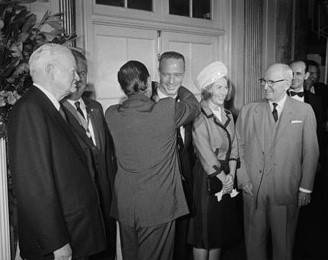
Left: President John F. Kennedy, second from left, hosts the Carpenters at the White House. Right: At the Waldorf-Astoria Hotel in New York, Mayor Robert F. Wagner presents astronaut M. Scott Carpenter with the New York Gold Medal of Honor, as his wife Rene and former Presidents Herbert C. Hoover, left, and Harry S. Truman look on.
On June 5, the Carpenters traveled first to Washington, D.C., where President Kennedy hosted them at the White House. Of Carpenter and his fellow astronauts, President Kennedy said, “I cannot imagine better representatives of what we like to think our country stands for than the … men who have taken part in these flights.” Although no ticker tape parade had been planned for them in New York, well-wishers showered them with confetti as they made their way through the streets of the city to the Waldorf-Astoria Hotel. In a ceremony attended by former Presidents Herbert C. Hoover and Harry S. Truman, New York Mayor Robert F. Wagner presented Carpenter with the city’s Gold Medal of Honor.
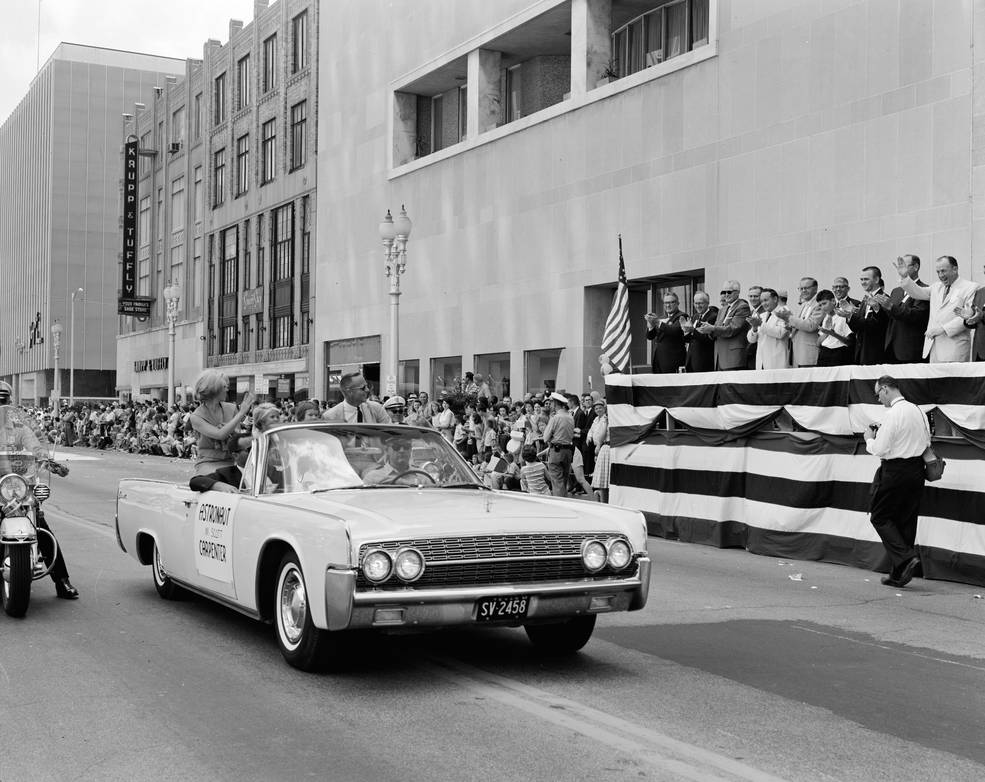
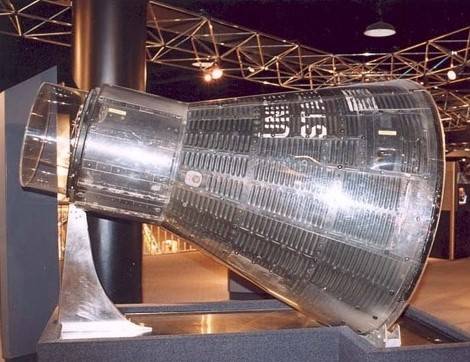
Left: The Carpenters ride in the Fourth of July parade in Houston. Right: The Aurora 7 capsule on display at the Museum of Science and Industry in Chicago. Image credit: Courtesy National Air and Space Museum.
Carpenter, along with the other Mercury astronauts, headed to Houston to see the newly-opened Manned Spacecraft Center, now NASA’s Johnson Space Center. To welcome the astronauts and ring in the new facility, the city’s Chamber of Commerce sponsored a parade and a Texas-sized barbecue on July 4, 1962. Each of the seven Mercury astronauts, including Carpenter, had their own convertible in the parade. Carpenter’s spacecraft, Aurora 7, following safing and cleanup at Cape Canaveral, would go on to tour for several years. In 1967, NASA turned the spacecraft over to the Smithsonian Institution’s Air Museum, the forerunner of today’s National Air and Space Museum in Washington D.C. The museum loaned it to other facilities on a temporary basis, finally in 1986 to the Museum of Science and Industry in Chicago, where it remains on display today.


